 |
| Go is a game in which the players compete in surrounding territory, but you can remove enemy stones from the board if you surround them vertically and horizontally. Also, if you steal away the living space of a group, it will die, so you can remove it from the board at the end of the game. Capturing enemy stones and killing enemy groups is one of the fascinating parts of Go. People who have just learned to play may become fascinated by this element of the game. |
 |
[1]Living with two eyes

(a) The smallest life
· The smallest living shape is one in which you build two spaces where the opponent can't play. Dia. 1 shows a live group with two eyes. White has surrounded all the outside points vertically and horizontally, but just the two X points are vacant. |
 |
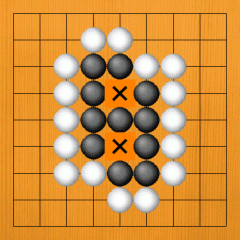
Dia. 1 |
|
If White next plays at the X point in Dia. 2, the stone he plays is itself surrounded by Black, so it is taken off the board the moment it is played. Since such a stone can't exist on the board, playing it is a 'forbidden move'. Basically, you can't play on a point where your stone can't exist. |
 |
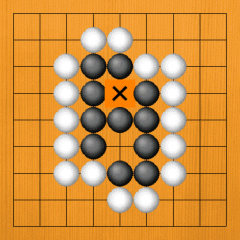
Dia. 2 |
|
· Dia. 3 is different. Black has only one vacant X point, so this black group is not alive. If White plays a stone here, it may be surrounded by black stones, but Black has only one vacant point. |
 |
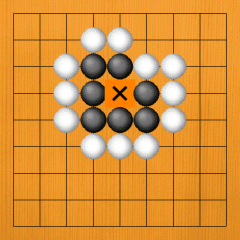
Dia. 3 |
|
Dia. 4. If White plays at 1, he can capture the black stones and remove them from the board. When you have only one vacant point inside your group, you have only 'one eye', so the group is dead. You need two eyes to live. |
 |
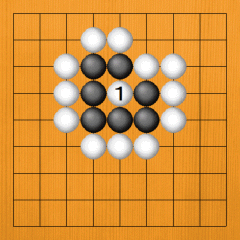
Dia. 4 |
|
· How about Dia. 5? |
 |
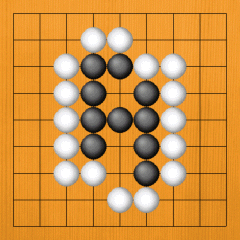
Dia. 5 |
|
Dia. 6. If it is Black's turn to play, he can play at 1. This reverts to the living shape in Dia. 1. White can no longer attack the group. |
 |
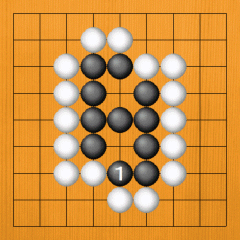
Dia. 6 |
Dia. 7. However, if it is White's turn to play, he can play at 1, so Black has only one eye. The X point is still vacant, but even if he plays here Black can't get two eyes. Whatever Black does, he has only one eye. In short, this black group is already dead.
However, during a game you must not say to the opponent, 'Your group is already dead.' Your opponent will either feel humiliated or enraged, so nothing good will come of it. Let's play with dignity. Perhaps the furthest you can go is to ask him, 'Haven't you overlooked something?' |
 |
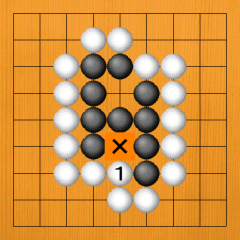
Dia. 7 |
(b) Life and death on the side
· It's easier to make two eyes on the side. The group in Dia. 8 is alive. Black is surrounded by White, but he has the two vacant X points, so he is alive with two eyes. White can't play into either point. |
 |
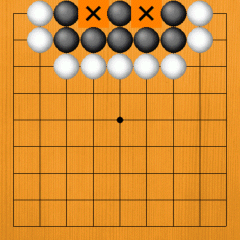
Dia. 8 |
|
Dia. 9. This black group is dead, of course, because he has only one vacant point, at X. |
 |
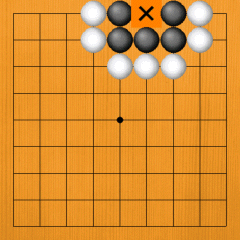
Dia. 9 |
|
Dia. 10. If White plays at 1, he can remove this black group from the board. |
 |
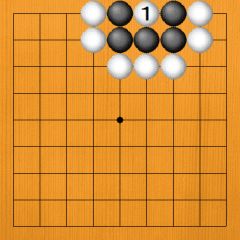
Dia. 10 |
|
· How about the group in Dia. 11? |
 |
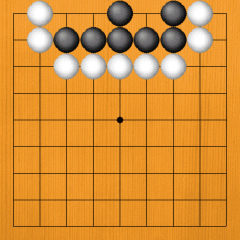
Dia. 11 |
|
Dia. 12. If it is Black's turn to play, he can live by making two eyes with 1. |
 |
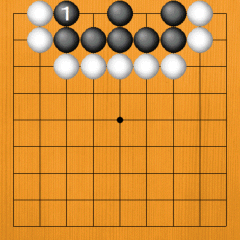
Dia. 12 |
|
Dia. 13. On the other hand, if it is White's turn to play, he can kill Black by playing at 1. The X point is still open, but Black can't build an eye there, so, with only one eye, he is already dead. |
 |
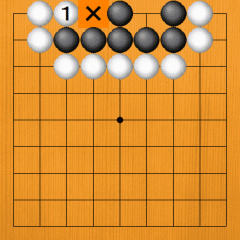
Dia. 13 |
(c) Two separate eyes
· Dia. 14. Black has two vacant X points here, but he can't live. |
 |
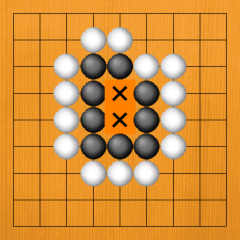
Dia. 14 |
|
Dia. 15. If White plays at 1, Black has only one eye even if he captures this stone, so Black is dead. |
 |
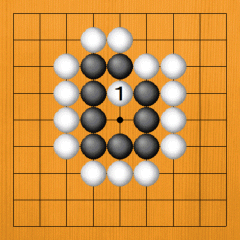
Dia. 15 |
|
Dia. 16. Also, playing Black 1 first is meaningless. In short, the group in Dia. 14 has no way of living. |
 |
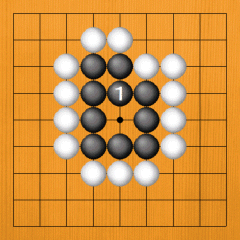
Dia. 16 |
|
(d) Three points
· Dia. 17. The group here has three vacant X points, but Black still has to be careful. |
 |
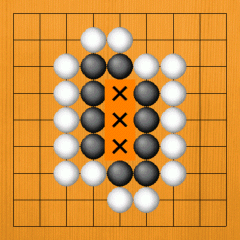
Dia. 17 |
|
Dia. 18. If it is Black's turn, he can play at 1. He lives because he has two separate vacant X points. However, things are different if it's White's turn to play. |
 |
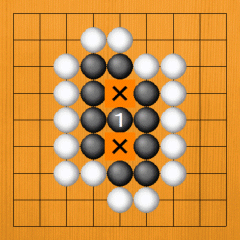
Dia. 18 |
|
Dia. 19. If White plays in the centre at 1, Black is reduced to one eye. Black is now helpless. |
 |
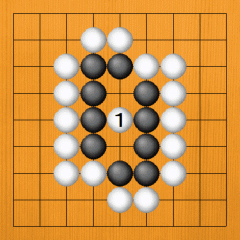
Dia. 19 |
|
Dia. 20. Even if Black plays at 1, he gets only one eye. |
 |
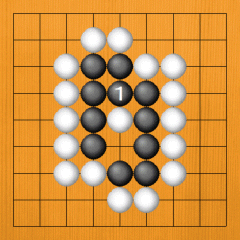
Dia. 20 |
|
Dia. 21. If White plays at 1, he takes the black stones off the board, |
 |
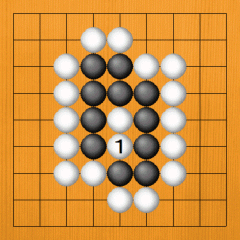
Dia. 21 |
(e) Four vacant points
· Dia. 22. This black group has four vacant points inside it. Black is alive even if White plays first. |
 |
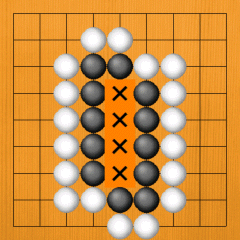
Dia. 22 |
|
Dia. 23. Even if White plays at 1, Black answers at 2, and Black has two separate vacant points, so White can't do anything. |
 |
Dia. 23
|
|
Let's look at Dia. 24. If White plays at 'a', his stone is immediately taken off the board, so this is a forbidden move. The same is true of 'b': White can't play here. White can't do anything. |
 |
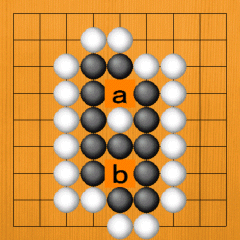
Dia. 24 |
|
·The only thing is that if the four vacant points are shaped differently, the result changes. Black has four vacant points in Dia. 25, but this shape is already dead. |
 |
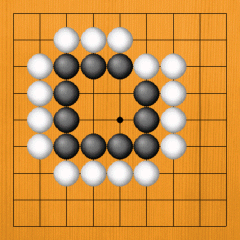
Dia. 25 |
|
Dia. 26. If Black plays 1 first, he may get three vacant points, but White plays on the centre point with 2, reducing Black to one eye. Whether or not having four vacant points secures life depends on the shape, so you have to be careful. |
 |
Dia. 26
|
|
·Well, let's study a different shape. In Dia. 27, Black has a bent four-point shape. Is this alive? |
 |
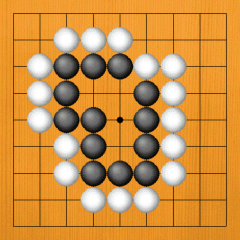
Dia. 27 |
|
Dia. 28. Even if White plays at 1 first, Black answers with 2 and has two separate vacant points, so this group is alive. |
 |
Dia. 28
|
|
Dia. 29. Even if White plays at 1 here, Black is alive with 2. The bent four-point shape is alive. |
 |
Dia. 29
|
(f) Five points
· Let's look at a five-point shape now. If the black group in Dia. 30 alive? |
 |
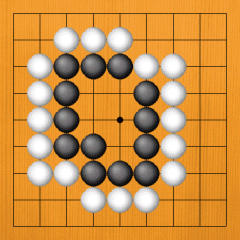
Dia. 30 |
|
Dia. 31. If it is Black's turn, he plays at 1. He has two separate vacant points, so he is alive. |
 |
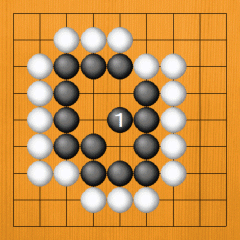
Dia. 31 |
|
Dia. 32. However, if it is White's turn, he plays at 1, causing problems. Even if Black plays at 2, White plays at 3, and Black can't make two separate vacant points. Even if Black next plays on the X points and captures White 1 and 3, this doesn't help. |
 |
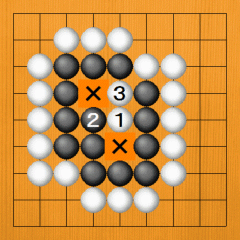
Dia. 32 |
|
Dia. 33. If Black plays at 1, White plays 2 and captures all the black stones. |
 |
Dia. 33
|
|
Even if Black doesn't play at 1, White plays at 1 in Dia. 34. Even if Black captures with 2. |
 |
Dia. 34
|
|
Dia. 35. White plays at 1, and Black can't make two separate eyes. Even if you have five vacant points inside your group, it may die, depending on the shape, so you have to be careful. |
 |
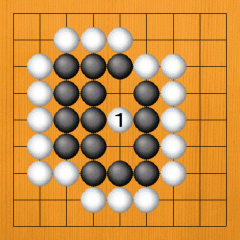
Dia. 35 |
|
 |